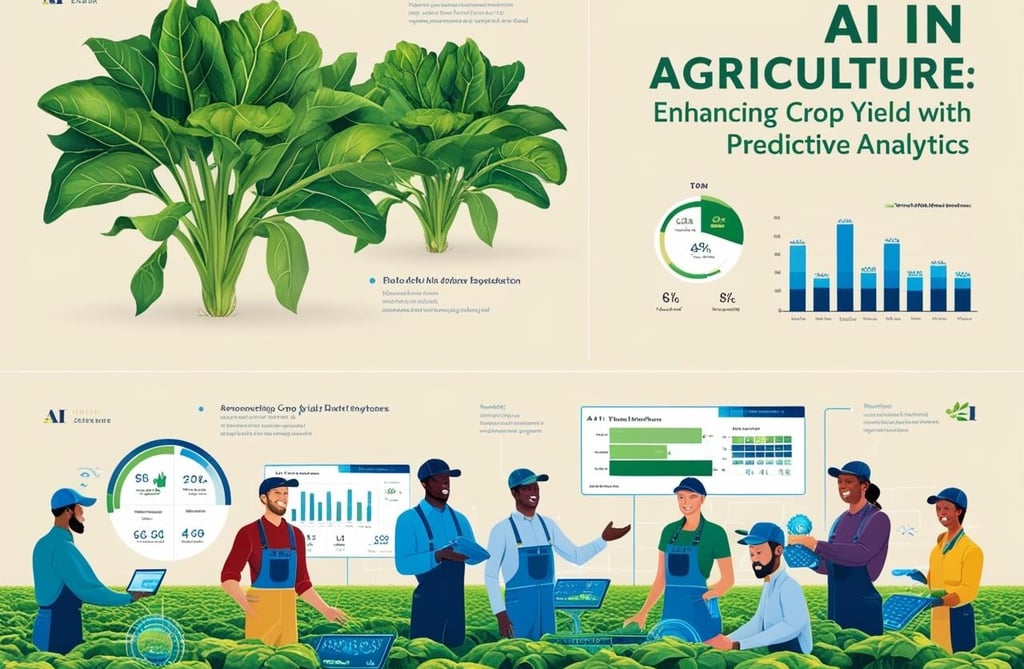AI in Agriculture: Enhancing Crop Yield with Predictive Analytics
Showcase an agritech company’s use of AI to analyze weather patterns, soil conditions, and pest risks. Discuss how this data-driven approach helped farmers make timely decisions, increasing yields and sustainability.
CASE STUDY


Agriculture has always been a cornerstone of human civilization, but modern challenges such as climate change, population growth, and resource scarcity demand innovative solutions. Enter artificial intelligence (AI), a transformative technology revolutionizing the agricultural sector. By leveraging predictive analytics, AI empowers farmers to optimize crop yields, reduce waste, and ensure food security.
This blog explores the role of AI-driven predictive analytics in agriculture, its benefits, challenges, and real-world applications through a compelling case study. Discover how this cutting-edge technology is reshaping farming practices and paving the way for a sustainable future.
The Role of AI in Modern Agriculture
AI encompasses various technologies, including machine learning, computer vision, and data analytics, which are collectively transforming farming practices. Predictive analytics, a subset of AI, uses historical and real-time data to forecast future outcomes, enabling data-driven decision-making.
Key Applications of Predictive Analytics in Agriculture
1. Crop Monitoring: Identifying growth patterns and detecting anomalies through satellite imagery and IoT sensors.
2. Weather Forecasting: Providing hyper-localized weather predictions to guide planting, irrigation, and harvesting schedules.
3. Pest and Disease Detection: Predicting outbreaks to facilitate timely interventions.
4. Yield Optimization: Estimating potential yields and recommending practices to maximize productivity.
5. Resource Management: Optimizing water, fertilizer, and pesticide usage to reduce costs and environmental impact.
Benefits of Predictive Analytics in Agriculture
1. Increased Crop Yields
By analyzing soil conditions, weather patterns, and crop health, predictive analytics enables farmers to make informed decisions that maximize yields.
2. Cost Efficiency
Optimizing resource usage reduces input costs while maintaining or enhancing output quality.
3. Risk Mitigation
AI models help farmers anticipate and prepare for potential risks, such as extreme weather events or pest infestations.
4. Sustainability
Data-driven farming practices minimize environmental impact by reducing waste and conserving resources.
5. Real-Time Insights
AI tools provide actionable insights in real-time, allowing for swift adjustments to farming practices.
Challenges in Implementing Predictive Analytics in Agriculture
While the benefits are substantial, several hurdles must be overcome:
1. Data Availability and Quality: Insufficient or poor-quality data can hinder AI model accuracy.
2. Infrastructure Gaps: Rural areas often lack the necessary technological infrastructure to support advanced analytics.
3. Cost of Implementation: High initial investment in sensors, software, and training can be prohibitive for small-scale farmers.
4. Skill Gap: Farmers may require training to effectively utilize AI tools.
5. Climate Variability: Rapidly changing environmental conditions can challenge the reliability of predictive models.
Case Study: Predictive Analytics in Agriculture at GreenGrow Farms
Background
GreenGrow Farms, a mid-sized agricultural enterprise specializing in wheat and corn production, faced declining yields due to unpredictable weather patterns and soil degradation. The company sought to integrate AI-powered predictive analytics to optimize their farming practices and enhance productivity.
Implementation
1. Objectives:
- Increase crop yield by 25% within two years.
- Reduce water and fertilizer usage by 15%.
- Improve pest and disease management.
2. Technology Stack:
- IoT Sensors: Deployed across fields to monitor soil moisture, nutrient levels, and temperature.
- Satellite Imagery: Provided comprehensive crop health assessments.
- Machine Learning Models: Predicted yield outcomes and recommended interventions.
- Mobile App: Delivered real-time insights to farmers.
3. Process:
- Data Collection: IoT sensors and satellite imagery collected data on soil and crop conditions.
- Model Training: Historical weather data, soil profiles, and pest activity were used to train machine learning algorithms.
- Actionable Insights: AI models generated recommendations for irrigation, fertilization, and pest control.
- Monitoring and Adjustment: Farmers used the mobile app to monitor crop conditions and implement AI-driven strategies.
Results
After one full growing season, GreenGrow Farms achieved the following:
1. Yield Improvement: Crop yields increased by 28%, surpassing the initial target.
2. Resource Efficiency: Water usage decreased by 20%, and fertilizer application dropped by 18%.
3. Pest Control: Early detection and targeted interventions reduced pest-related crop losses by 40%.
4. Sustainability Gains: Improved resource management reduced greenhouse gas emissions, enhancing the farm’s environmental profile.
Farmer Feedback
Farmers at GreenGrow Farms praised the AI system’s accuracy and ease of use, though they noted a learning curve in interpreting certain data insights. Overall, the integration of predictive analytics was viewed as a game-changer for the enterprise.
Future Trends in AI and Predictive Analytics for Agriculture
1. Integration with Robotics
AI-powered robots equipped with sensors and cameras will enable automated crop monitoring, harvesting, and pest control.
2.Combining predictive analytics with blockchain technology
AI will enhance supply chain transparency allowing consumers to trace food origins and quality.
3. Advanced Weather Modeling
AI will improve the granularity and accuracy of weather predictions, offering farmers more precise guidance.
4. Customized AI Solutions
Scalable, customizable AI platforms tailored to specific crops and regions will make predictive analytics accessible to small-scale farmers.
5. AI-Driven Market Insights
By analyzing market trends, AI can help farmers decide which crops to plant and when to sell, maximizing profitability.
Conclusion
AI-driven predictive analytics is revolutionizing agriculture, enabling farmers to achieve higher yields, reduce costs, and operate more sustainably. The case study of GreenGrow Farms demonstrates the transformative potential of this technology, highlighting its ability to deliver tangible benefits while addressing critical challenges.
As AI tools become more sophisticated and accessible, their adoption in agriculture will likely accelerate, fostering innovation and resilience in the face of global challenges. For farmers, policymakers, and tech enthusiasts, predictive analytics represents a critical pathway to a sustainable and food-secure future.
Explore more groundbreaking AI tools and innovations shaping industries at "AI in Entertainment: How It's Revolutionizing Movies, Music, and Gaming", your trusted resource for AI insights and advancements.
Read more relevant articles at: "Personalized Learning: A Case Study on AI in K-12 Education".

